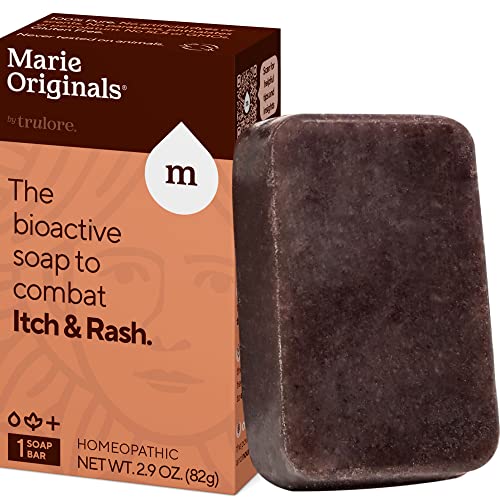


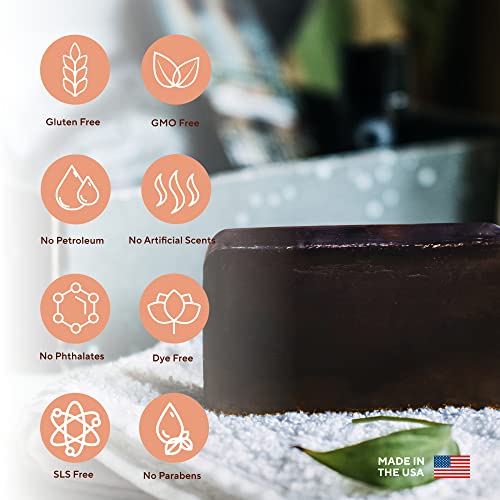
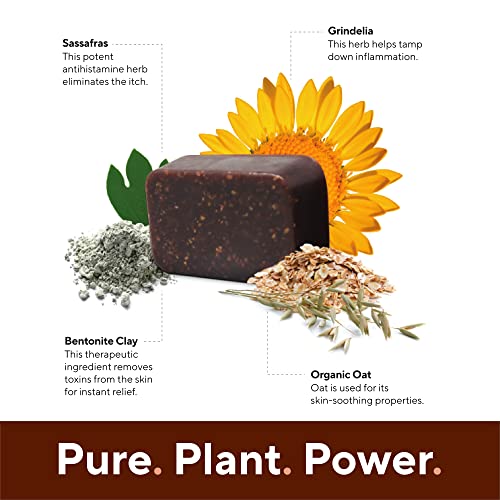
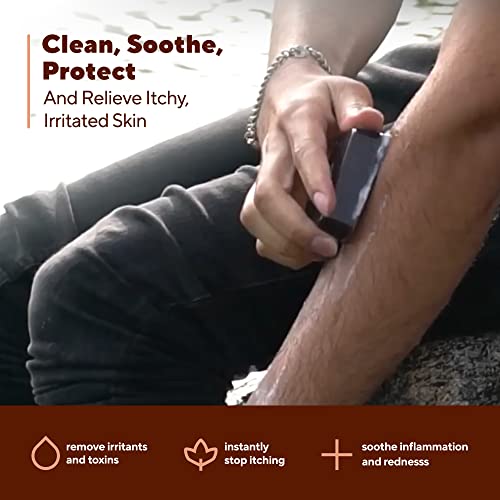
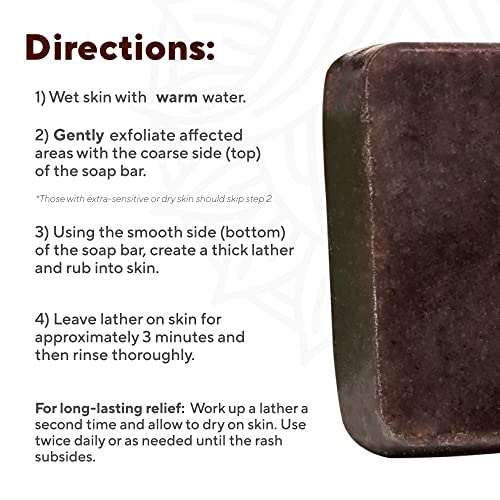
Marie Originals Body Soap - Natural Relief for Itchy Skin, Gentle Ingredients - 4oz Bar


Cocos Nucifera (Coconut) Oil
Low RiskCocos Nucifera (Coconut) Oil is derived from the kernels of the coconut palm. It is primarily used in cosmetic formulations for its emollient and moisturizing properties, making it suitable for skin and hair care products.
Sustai Insights
Coconut oil serves as an effective moisturizer and emollient, promoting skin hydration and softness. It is sustainably sourced and biodegradable. Health risks are minimal, with low concerns regarding carcinogenicity, allergens, and reproductive toxicity. Environmental impact is also low, as it does not contribute significantly to pollution or bioaccumulation. Regulatory bodies have not issued restrictions on its use. Overall, coconut oil presents a low risk for health and environmental concerns, making it a safe ingredient in cosmetic products.
Avena Sativa (Oat) Kernel Protein
Low RiskAvena sativa (oat) kernel protein is a protein derived from oats, commonly used in cosmetic formulations for its moisturizing and film-forming properties. It is known for its ability to enhance skin hydration and improve product texture, making it a popular ingredient in skin and hair care products.
Sustai Insights
Avena sativa (oat) kernel protein offers functional benefits such as hydration and improved product texture, contributing positively to cosmetic formulations. It is considered to have low health risks, with no significant concerns regarding carcinogenicity, allergies, or reproductive toxicity. Environmentally, it is not recognized as a pollutant or bioaccumulative. Regulatory bodies do not impose significant restrictions on its use. Overall, the risk level associated with this ingredient is low, and its use in products is generally safe. Alternatives include other plant-based proteins that provide similar benefits.
Avena Sativa (Oat) Bran
Low RiskAvena sativa (oat) bran is the outer layer of the oat grain, commonly used in cosmetics for its soothing and moisturizing properties. It contains various beneficial compounds, including beta-glucans, which contribute to its effectiveness in skin care formulations.
Sustai Insights
Avena sativa (oat) bran provides functional benefits such as moisturizing and soothing properties, making it effective in skincare products. It is sustainably sourced and biodegradable, presenting minimal environmental risks. Health risks are classified as low, with no significant concerns regarding carcinogenicity, allergenic potential, or reproductive toxicity. Regulatory assessments indicate no restrictions on its use. Overall, the ingredient poses a low risk, and no significant safer alternatives are necessary.
Salix Alba (White Willow)
Low RiskSalix alba, commonly known as white willow, is a tree whose bark is traditionally used for its salicylate content, which is chemically related to aspirin. It is primarily utilized in herbal remedies and cosmetic formulations for its anti-inflammatory and analgesic properties.
Sustai Insights
White willow is valued for its functional benefits, particularly its anti-inflammatory and pain-relieving effects, making it useful in topical applications. It is considered low risk for health concerns, including cancer, allergies, and reproductive toxicity. Environmentally, it poses minimal hazards, with no bioaccumulation noted. Regulatory bodies do not impose restrictions on its use. Safe practices involve using it as directed, and alternatives like willow bark extract can be considered for similar benefits. Overall, white willow presents a low risk profile.
Carthamus Tinctorius (Safflower) Seed Oil
Low RiskCarthamus tinctorius (safflower) seed oil is derived from the seeds of the safflower plant. It is primarily used in cosmetic formulations for its emollient properties, helping to moisturize and soften the skin. The oil is rich in unsaturated fatty acids and is often employed in skin care products for its potential benefits to skin health.
Sustai Insights
Safflower seed oil offers functional benefits as a moisturizer and emollient, contributing to skin hydration without significant irritation. It is generally recognized as low risk concerning health impacts, with minimal concerns over carcinogenicity, allergies, and reproductive toxicity. Environmentally, it poses low risks, being non-bioaccumulative and not a significant pollutant. Regulatory bodies do not impose restrictions on its use, underscoring its safety profile. While there are no widely recognized safer alternatives, users should ensure proper application to mitigate any potential skin irritation. Overall, this ingredient is assessed as low risk.
Elaeis Guineensis (Palm) Kernel Oil
Low RiskElaeis guineensis (palm) kernel oil is an oil derived from the seeds of the African oil palm tree. It functions primarily as an emollient and moisturizing agent in cosmetic formulations, enhancing texture and providing moisture retention.
Sustai Insights
Elaeis guineensis (palm) kernel oil offers functional benefits as a moisturizing agent and is often sustainably sourced. Health risks are low, with minimal concerns regarding carcinogenicity, allergies, or reproductive toxicity. Environmental risks appear low, with no significant pollutant or bioaccumulation issues reported. Regulatory bodies impose few restrictions, suggesting overall low risk. Safe usage practices recommend using it within established concentrations, while alternatives such as coconut oil may be considered for similar functions. Overall, this ingredient presents a low risk profile.
Cocos Nucifera (Coconut) Oil
Low RiskCocos Nucifera (Coconut) Oil is derived from the kernels of the coconut palm. It is primarily used in cosmetic formulations for its emollient and moisturizing properties, making it suitable for skin and hair care products.
Sustai Insights
Coconut oil serves as an effective moisturizer and emollient, promoting skin hydration and softness. It is sustainably sourced and biodegradable. Health risks are minimal, with low concerns regarding carcinogenicity, allergens, and reproductive toxicity. Environmental impact is also low, as it does not contribute significantly to pollution or bioaccumulation. Regulatory bodies have not issued restrictions on its use. Overall, coconut oil presents a low risk for health and environmental concerns, making it a safe ingredient in cosmetic products.
Avena Sativa (Oat) Kernel Protein
Low RiskAvena sativa (oat) kernel protein is a protein derived from oats, commonly used in cosmetic formulations for its moisturizing and film-forming properties. It is known for its ability to enhance skin hydration and improve product texture, making it a popular ingredient in skin and hair care products.
Sustai Insights
Avena sativa (oat) kernel protein offers functional benefits such as hydration and improved product texture, contributing positively to cosmetic formulations. It is considered to have low health risks, with no significant concerns regarding carcinogenicity, allergies, or reproductive toxicity. Environmentally, it is not recognized as a pollutant or bioaccumulative. Regulatory bodies do not impose significant restrictions on its use. Overall, the risk level associated with this ingredient is low, and its use in products is generally safe. Alternatives include other plant-based proteins that provide similar benefits.
Avena Sativa (Oat) Bran
Low RiskAvena sativa (oat) bran is the outer layer of the oat grain, commonly used in cosmetics for its soothing and moisturizing properties. It contains various beneficial compounds, including beta-glucans, which contribute to its effectiveness in skin care formulations.
Sustai Insights
Avena sativa (oat) bran provides functional benefits such as moisturizing and soothing properties, making it effective in skincare products. It is sustainably sourced and biodegradable, presenting minimal environmental risks. Health risks are classified as low, with no significant concerns regarding carcinogenicity, allergenic potential, or reproductive toxicity. Regulatory assessments indicate no restrictions on its use. Overall, the ingredient poses a low risk, and no significant safer alternatives are necessary.
Salix Alba (White Willow)
Low RiskSalix alba, commonly known as white willow, is a tree whose bark is traditionally used for its salicylate content, which is chemically related to aspirin. It is primarily utilized in herbal remedies and cosmetic formulations for its anti-inflammatory and analgesic properties.
Sustai Insights
White willow is valued for its functional benefits, particularly its anti-inflammatory and pain-relieving effects, making it useful in topical applications. It is considered low risk for health concerns, including cancer, allergies, and reproductive toxicity. Environmentally, it poses minimal hazards, with no bioaccumulation noted. Regulatory bodies do not impose restrictions on its use. Safe practices involve using it as directed, and alternatives like willow bark extract can be considered for similar benefits. Overall, white willow presents a low risk profile.
Carthamus Tinctorius (Safflower) Seed Oil
Low RiskCarthamus tinctorius (safflower) seed oil is derived from the seeds of the safflower plant. It is primarily used in cosmetic formulations for its emollient properties, helping to moisturize and soften the skin. The oil is rich in unsaturated fatty acids and is often employed in skin care products for its potential benefits to skin health.
Sustai Insights
Safflower seed oil offers functional benefits as a moisturizer and emollient, contributing to skin hydration without significant irritation. It is generally recognized as low risk concerning health impacts, with minimal concerns over carcinogenicity, allergies, and reproductive toxicity. Environmentally, it poses low risks, being non-bioaccumulative and not a significant pollutant. Regulatory bodies do not impose restrictions on its use, underscoring its safety profile. While there are no widely recognized safer alternatives, users should ensure proper application to mitigate any potential skin irritation. Overall, this ingredient is assessed as low risk.
Elaeis Guineensis (Palm) Kernel Oil
Low RiskElaeis guineensis (palm) kernel oil is an oil derived from the seeds of the African oil palm tree. It functions primarily as an emollient and moisturizing agent in cosmetic formulations, enhancing texture and providing moisture retention.
Sustai Insights
Elaeis guineensis (palm) kernel oil offers functional benefits as a moisturizing agent and is often sustainably sourced. Health risks are low, with minimal concerns regarding carcinogenicity, allergies, or reproductive toxicity. Environmental risks appear low, with no significant pollutant or bioaccumulation issues reported. Regulatory bodies impose few restrictions, suggesting overall low risk. Safe usage practices recommend using it within established concentrations, while alternatives such as coconut oil may be considered for similar functions. Overall, this ingredient presents a low risk profile.
Discover lasting relief from itchy, inflamed skin with Marie Originals Itch Relief Soap Body Wash Bar. This all-natural soap harnesses the power of potent herbs and detoxifying ingredients to soothe irritations caused by insect bites, chicken pox, and more.
- Natural Itch Relief: This soap helps remove irritants and toxins, providing instant relief from discomfort.
- Effective Ingredients: Featuring noni, white willow, and bentonite clay, it alleviates swelling and irritation while detoxifying the skin.
- Quality Made in the USA: Proudly produced in America, this soap meets the highest industry standards for quality and safety.
- Gentle and Safe: Free from harmful chemicals, this soap is cruelty-free and suitable for sensitive skin, making it safe for kids and adults alike.
- Versatile Use: Ideal for washing the face and body, this therapeutic soap can be used daily to maintain relief from itching and irritation.
Subscribe & Save with Sustai
- Best Price Guarantee: Always enjoy the lowest prices on sustainable home essentials.
- No Surprises: We’ll notify you before shipping. No hidden fees, ever.
- You’re in Charge: Change, pause, or cancel your subscription anytime with ease.
- Eco-Friendly Deliveries: Our grouped shipments mean less packaging and lower emissions.
Join us on a sustainable journey. Special offers for a limited time! Prices and promotions may change.
Recommended Products
Discover lasting relief from itchy, inflamed skin with Marie Originals Itch Relief Soap Body Wash Bar. This all-natural soap harnesses the power of potent herbs and detoxifying ingredients to soothe irritations caused by insect bites, chicken pox, and more.
- Natural Itch Relief: This soap helps remove irritants and toxins, providing instant relief from discomfort.
- Effective Ingredients: Featuring noni, white willow, and bentonite clay, it alleviates swelling and irritation while detoxifying the skin.
- Quality Made in the USA: Proudly produced in America, this soap meets the highest industry standards for quality and safety.
- Gentle and Safe: Free from harmful chemicals, this soap is cruelty-free and suitable for sensitive skin, making it safe for kids and adults alike.
- Versatile Use: Ideal for washing the face and body, this therapeutic soap can be used daily to maintain relief from itching and irritation.

You can have at most 2 Sustainable Steals products in your cart
Customer Reviews
Customers’ View
Customers appreciate the effective itch relief and moisturizing properties of this all-natural body soap. Many users report immediate and lasting relief from skin irritations, with comments highlighting its soothing effects on insect bites and rashes. The soap's gentle formula is noted as suitable for sensitive skin, making it a preferred choice for families. However, some customers express mixed feelings about its value for money and size, suggesting it may be on the pricier side for the quantity provided. Despite this, the natural ingredients, including noni and white willow, resonate well with those prioritizing eco-friendly and health-conscious products. Overall, many find this soap both beneficial for skin comfort and aligned with their sustainable lifestyle choices.
AI-generated from the text of customer reviewsThis product is rated 5.0 of 5.0 stars.
It has received 1 review.




